
On the Road to Calais is a 1919 song performed by Al Jolson in the 1918 musical Sinbad. The music was composed by Jolson with the lyrics written by Alfred Bryan. It was published by Jerome H. Remick & Co.

The cover has George Washington, Betsy Ross, and her helper.
Edward Frederick Teschemacher, was a prolific writer of song lyrics. He was born at Highbury, Middlesex, England and he was educated at Giggleswick School, Settle, North Yorkshire.

"Yankee Boy" is a World War I song. Lyrics were written by Fred Ziemer, and music was composed by J.R. Shannon. Vandersloot Music Publishing Company produced the song in 1918. On the cover of the sheet music, there is a soldier in a trench, throwing a grenade. The song was written for both voice and piano. The lyrics show support for the soldiers fighting in the war, and how the Yankee Boy will "win both fame and glory."

"You Can't Stop the Yanks ", also written as "You Can't Stop the Yanks Till They Go Right Thru Berlin" is a World War I era song released in 1918. Lyrics and music were written by Jack Caddigan and Chick Story. It was published by Lang Music Publishing Co. of Boston. It was written for both voice and piano, and dedicated to the American Army and Navy. On the cover are soldiers with their weapons drawn standing in France. Across the Rhine River in Berlin, Germany, are presumably depictions of the three German leaders: Paul von Hindenburg, Kaiser Wilhelm II, and Erich Ludendorff. All three look surprised and angry as they size up the American troops nearing Germany.

"Allegiance: Patriotic Song" is a World War I song first copyrighted on March 14, 1918.

Keep the Love-Light Burning in the Window Till the Boys Come Marching Home is a World War I song with music and lyrics by Jack Caddigan and Jimmy McHugh. It was first published in May, 1917, a month after the United States entered World War I, by D. W. Cooper Publishing Co., in Boston, MA. By October, Chappell & Co. had brought suit, alleging that the title and refrain violated copyright on the British song, "Keep the Home-Fires Burning." Cooper settled out of court by agreeing to release a second edition, copyrighted October 23, 1917, with revised lyrics and the title "Keep the Love-Light Shining in the Window." In the meantime, Jos. W. Stern & Co. had acquired sole selling rights, and its imprint, along with Cooper's, appeared on the new version. A final edition, issued after Stern & Co. actually acquired the copyright, appeared in 1918.

Don't Cry Frenchy, Don't Cry is a 1919 song written during World War I. The lyrics were written by Sam M. Lewis and Joe Young, and the music was written by Walter Donaldson.The song was published by Waterson, Berlin & Snyder Company in New York City.
"America! My Home-Land" is a World War I song written by Henry Treleaven and composed by Richard Blaine. This song was published in 1917 by Boosey & Co. in New York, NY.
When I Come Back To You is a World War I song written and composed by William Tracey and Jack Stern. The song was first published in 1918 by Douglas & Newman Music in New York, NY.The sheet music cover depicts a soldier hugging a woman with the Liberty Bell in the background.
Melville Bernd Kaufman was a prolific American ragtime piano composer.

Amy Ashmore Clark was a Canadian-born American songwriter, composer, and businesswoman, "equally popular and successful as a writer of lyrics for other people's music, and a writer music for other people's lyrics", despite being unable to read or write music. She also appeared in musical comedy and vaudeville, worked in music publishing, and at several magazines.
"America's Crusaders" is a World War I song with words and music written by Charles Fonteyn Manney. It was copyrighted on August 16, 1918, and published by Oliver Ditson in Boston in two forms: for four-part ensemble of mixed voices and for four-part ensemble of male voices, with baritone soloist.

George Wayne Fairman (1881–1962) was a lyricist, composer, and music publisher whose work includes popular songs. Several of his songs charted including two that reached #1. Fairman's work includes coon songs, ragtime, songs related to World War I, and a foxtrot.
Joseph Erskine Agnew was a musician, arranger, music store proprietor, and music publisher in Des Moines, Iowa and later Newton, Iowa briefly. He played the mandolin. He became a nationally prominent band music publisher. Sheet music published by his Agnew Music Publishing Company is in the collections of the Library of Congress, the University of Missouri-Kansas City, and the University of Rochester.

Isidore Lillian was an actor, songwriter, playwright, and composer who was a leading figure in the New York Yiddish Theatre for the first half of the twentieth century. He wrote hundreds of songs for the theatre which were performed by such actors as Boris Thomashefsky, David Kessler, and Jacob Adler, as well as by Lillian himself.
Natalie Hannau Townsend was an American composer who was also known for organizing musicales in Washington, D.C.. She is listed in some sources as Pearl Dea Etta Townsend, and sometimes published her music as Madame Lawrence Townsend.

Stella Helen Gilmore was an American stage actress, composer, lyricist and magazine editor from Chicago, Illinois.

Ottalie Mark was an American musicologist, copyright consultant, composer, and music editor.
Dagmar de Corval Rybner Barclay was a Swiss-German composer, pianist, and teacher who worked and corresponded with Sergei Rachmaninoff. She published and performed under the name Dagmar Rybner.












